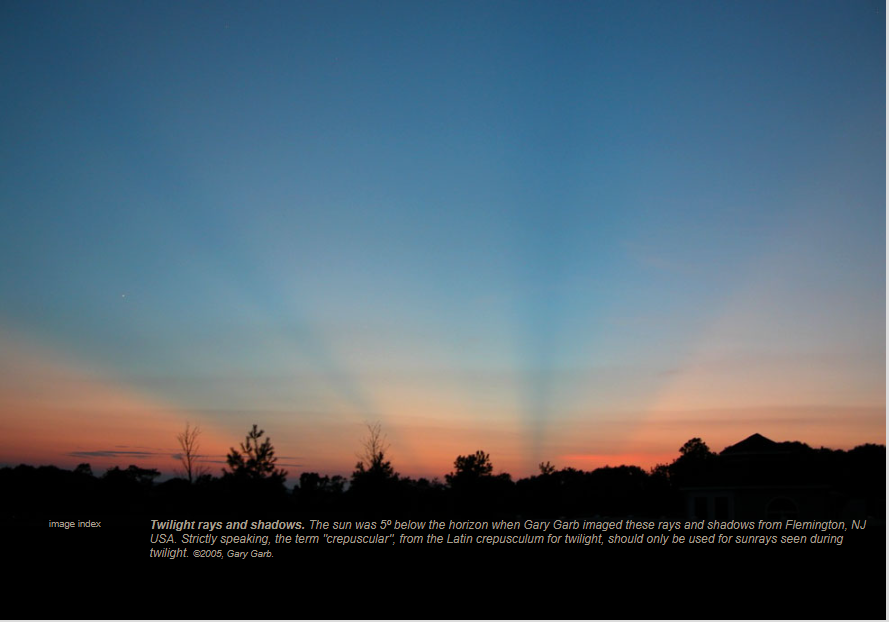Twilight rays and shadows
Twilight Rays and Shadows: A Phenomenon of Natural Beauty
Twilight rays and shadows are a captivating atmospheric optics phenomenon that occurs during the transition between day and night. As the sun descends below the horizon, it casts its warm glow upon the Earth, creating an ethereal display of light and shadow. These mesmerizing rays, also known as crepuscular rays, add a touch of magic to the twilight hours.
The Science Behind Twilight Rays
The formation of twilight rays is a result of the interaction between sunlight and atmospheric particles. When the sun is low on the horizon, its rays travel through a greater thickness of Earth's atmosphere. This causes the shorter blue and green wavelengths to scatter more, while the longer red and orange wavelengths remain relatively unscathed. As a result, the sunlight appears to take on a warm, golden hue.
The Role of Clouds in Enhancing Twilight Rays
Clouds play a crucial role in enhancing the visual impact of twilight rays. When clouds are present in the sky, they act as a canvas on which the rays can be beautifully painted. As the sunlight filters through gaps in the clouds, it creates distinct beams of light that appear to radiate from the sun's position. These beams can extend across the sky, creating a mesmerizing spectacle that captures the imagination.
Variations in Twilight Ray Patterns
Twilight rays can exhibit a variety of patterns, depending on the atmospheric conditions and the positioning of clouds. Some common variations include:
- Radial Rays: These rays appear to emanate from a central point, spreading outwards like the spokes of a wheel. They create a stunning visual effect, drawing attention to the sun's location below the horizon.
- Parallel Rays: In some instances, twilight rays may appear parallel to each other, resembling long, narrow bands of light stretching across the sky. This pattern can create a sense of depth and perspective.
- Broken Rays: When clouds are scattered across the sky, the rays can appear fragmented and irregular. This adds an element of dynamism and unpredictability to the scene, enhancing its visual appeal.
Shadows in Twilight
In addition to the mesmerizing rays, twilight also brings about intriguing shadow play. As the sun's position lowers, objects on the Earth's surface cast elongated shadows that stretch across the landscape. These elongated shadows create a dramatic contrast against the fading light, adding depth and dimension to the surroundings.
Twilight Rays and Cultural Significance
Throughout history, twilight rays have captivated and inspired human beings. These celestial displays have been depicted in countless works of art, literature, and mythology. Their ethereal beauty often symbolizes a sense of tranquility, wonder, and spiritual connection with the natural world.
Photographing Twilight Rays and Shadows
Capturing the ephemeral beauty of twilight rays and shadows can be a rewarding endeavor for photographers. To capture these atmospheric phenomena effectively, consider the following tips:
- Timing is crucial: Plan your photography session during the transition from day to night when the sun is low on the horizon.
- Choose your location wisely: Look for open spaces with unobstructed views of the sky to maximize the impact of the rays and shadows.
- Experiment with angles: Try different angles and perspectives to find the most captivating composition.
- Utilize filters: Neutral density filters can help balance the exposure between the bright rays and the darker surroundings, allowing for more balanced photographs.
The Magic of Twilight Rays and Shadows
Twilight rays and shadows are a testament to the awe-inspiring beauty of nature. As the sun bids farewell to another day, it leaves behind a breathtaking display of light and shadow. The interplay between sunlight, atmospheric particles, and clouds creates a visual symphony that evokes a sense of wonder and reverence. Whether you witness these phenomena firsthand or capture them through the lens of a camera, twilight rays and shadows remind us of the enchantment that exists in the world around us.

Twilight rays and shadows. The sun was 5º below the horizon when Gary Garb imaged these rays and shadows from Flemington, NJ USA. Strictly speaking, the term "crepuscular", from the Latin crepusculum for twilight, should only be used for sunrays seen during twilight. ©2005, Gary Garb.
Note: this article has been automatically converted from the old site and may not appear as intended. You can find the original article here.
Reference Atmospheric Optics
If you use any of the definitions, information, or data presented on Atmospheric Optics, please copy the link or reference below to properly credit us as the reference source. Thank you!
-
<a href="https://atoptics.co.uk/blog/twilight-rays-and-shadows/">Twilight rays and shadows</a>
-
"Twilight rays and shadows". Atmospheric Optics. Accessed on April 16, 2024. https://atoptics.co.uk/blog/twilight-rays-and-shadows/.
-
"Twilight rays and shadows". Atmospheric Optics, https://atoptics.co.uk/blog/twilight-rays-and-shadows/. Accessed 16 April, 2024
-
Twilight rays and shadows. Atmospheric Optics. Retrieved from https://atoptics.co.uk/blog/twilight-rays-and-shadows/.